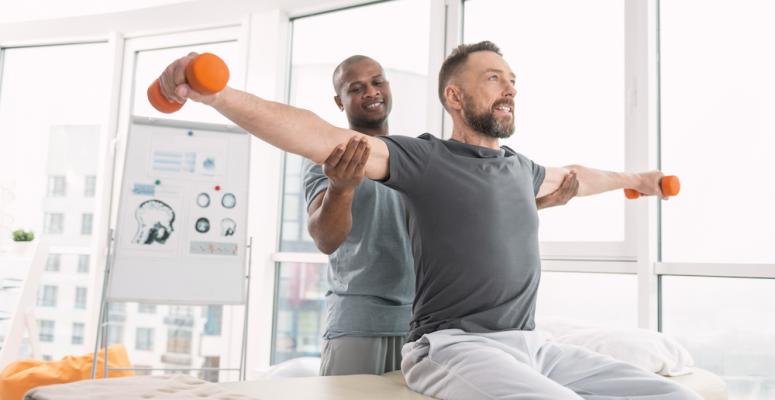
When it comes to your health and wellness, being proactive can make a significant difference in the long run. Instead of waiting until an issue occurs, it’s important to incorporate methods of prevention into your everyday life. This can mean anything from taking vitamins to reduce the risk of getting sick to scheduling regular health screenings with your doctors. It can also mean taking the right steps to prevent falls.
You may not think about the importance of your balance and stability on a daily basis. However, if you stumble over an uneven surface or fall down from tripping over clutter, you’ll recognize how important it is to improve your balance to reduce the risk of future injuries or accidents. One of the best ways to do that is through physical therapy exercises.
In this blog post, we’ll discuss a variety of physical therapy exercises that can help prevent falls as well as who the exercises can benefit the most.
6 fall prevention exercises used in physical therapy
When you’re going to physical therapy to help prevent falls, strength and balance exercises are likely a staple in your sessions. Strengthening exercises work to prevent falls by improving your body’s alignment and increasing joint stability during movement. Balance exercises involve boosting your coordination and your body’s ability to sense its position, known as proprioception. Many physical therapy exercises combine the goals of both improved strength and balance.
Read on to discover a variety of physical therapy exercises that can help prevent falls. Your physical therapist can walk you through how to perform them in a safe and effective manner. That way, you can perform them in between sessions and after your treatment is complete. Your therapist will instruct you on how many times to repeat each exercise. Keep in mind that some of these fall prevention exercises may require additional equipment, such as a chair.
- Toe stand — Hold on to the back of a chair. Slightly bend your knees while keeping your back straight. Push upward onto the balls of your feet until you’re on your tiptoes before lowering back down onto your heels. Repeat up to 15 times or as instructed by your physical therapist. Toe stands work to strengthen the muscles in your calves and ankles for increased stability.
- Knee curl — Hold on to the back of a chair. Stand with your back straight and your feet shoulder width apart while slightly bending your knees. Lift your right leg straight behind you. Bend your knee and bring the heel of your foot toward your buttocks. Return your leg to the starting position before switching to the left leg. Repeat up to 15 times for each leg or as instructed by your therapist. Knee curls help you strengthen the muscles in your lower back as well as your buttocks for increased spinal support.
- Sit-to-stand — Sit in a chair and plant your feet flat on the floor with your buttocks at the edge of the seat. While keeping your hands clasped together in front of you, lean your chest forward to shift your body weight. Rise off the chair into a standing position by squeezing your glutes. Slowly lower back down onto the chair. Repeat as directed by your physical therapist. The sit-to-stand exercise can strengthen your leg muscles and boost your body mechanics while moving. You may need to put the chair in front of a sturdy surface, such as a table, for support if needed.
- Wall slide — Stand with your back flat against a wall. Your feet should be placed in front of you and slightly away from the wall so that you’re leaning completely on the wall’s surface. Your legs should be a bit wider than shoulder width apart. Slowly slide down the wall until you’re in a half squat. Be sure that your kneecaps stay in line with your middle toes. Raise your body back up the wall into starting position. Repeat the exercise up to 10 times or as directed by your physical therapist. Wall slides can help strengthen your leg muscles for increased stability.
- Single-leg balance — Bend your right leg so that you're standing solely on your left leg. Try to hold your balance for 30 seconds or as instructed by your physical therapist. You can gradually add time as you improve your balance. This exercise not only helps you improve your balance, but it can also strengthen the ankle and knee ligaments and muscles. It can be done with or without using the back of a chair for additional support.
- Leg extension — Sit in a chair with your feet planted on the floor. Lift your left leg and extend it in front of you as much as possible before lowering it back down to resting position. Repeat up to 15 times or as instructed by your physical therapist before switching to do the same with your right leg. Leg extensions help prevent falls by strengthening your thigh muscles.
Who can benefit from fall prevention exercises?
The truth is that everyone can fall at some point, so fall prevention exercises can be beneficial for anyone. Everyday issues like dim lighting or unsupportive footwear can contribute to a fall.
However, some people may be at higher risk for falling than others, either due to natural aging or medical conditions, so these exercises should be a priority for them. Any condition that impacts your muscle strength, gait or balance could lead to a higher risk of falling.
The concern of falling is highest for older people, meaning 65 and older, because they are more at risk of breaking bones due to lower bone density. Approximately 1 million older people go to the hospital every year due to a fall-related injury.
Fall prevention exercises can be helpful for people who have:
- Poor or declining eyesight
- Fluctuating blood pressure
- Vestibular issues, such as vertigo
- A neurological disorder
- Multiple medication prescriptions
- Foot issues, such as corns or calluses
- Nerve damage in the legs
If you have any of the above conditions that you’re seeking physical therapy for, your personalized treatment plan will likely include fall prevention exercises such as leg extensions and wall slides. The goal is to improve each component that can increase the likelihood of falling, such as strength, balance and flexibility.
Along with fall prevention exercises, physical therapy sessions for improved strength and balance can also include:
- Manual therapy
- Balance training
- Vestibular rehabilitation
- Core strengthening
Alliance PTP can help find expert physical therapists near you to teach fall prevention exercises
Accidents happen. We all stumble every now and then. But the severity of a fall can vary from a few temporary bruises to pain that lasts weeks due to a fracture or sprain. It’s also important to remember that, as you get older, the damage from a fall can cause significant issues that have longer recovery times and lasting symptoms. The good news is that Alliance PTP can help.
You probably don’t have to go as far as you think to learn fall prevention exercises. After all, Alliance Physical Therapy Partners has practices across the country where you can find the physical therapy you need, from targeted exercises to core strengthening.
And if there isn’t one near you, don’t worry! We also offer highly effective and affordable virtual care in nearly every U.S. state.
So, don’t keep letting your symptoms affect your day-to-day life. Get in touch with our team today so we can help you find the physical therapy that’s right for you.
Get Help at a Location Near You
